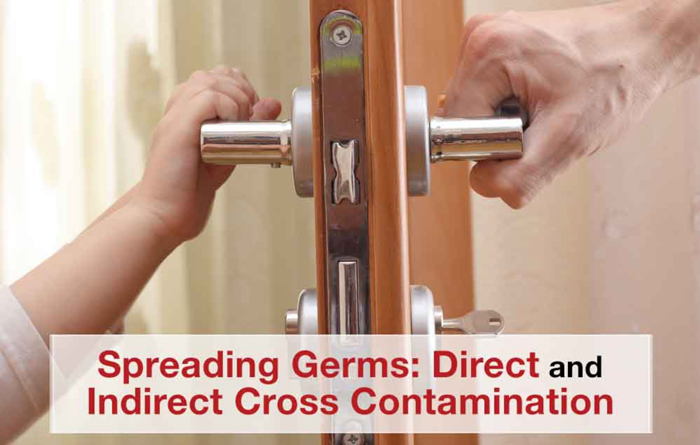Cross-contamination of a surface with germs and bacteria occurs one of two ways: directly or indirectly. Direct contamination of the flu would be when a sick person shakes hands with a healthy person and that person touches their face before washing their hands. Indirect contamination is when the sick person touches a doorknob and the next person to come along picks up their flu by touching that doorknob.
With regards to facilities, direct contamination can happen when something with bacteria (like potentially raw meat) is placed on a clean, non-treated surface. Indirect contamination happens when a dirty rag is used to wipe up after the raw meat and then used again on a clean surface. It transfers germs, dirt, bacteria, and other microbial matter from one surface to another under the guise of “cleaning”.
Keeping employees healthy should be a big consideration for any business. With regard to surface cleaning and sanitizing, there are ways to reduce the likelihood of cross-contamination.
Training

A big way to prevent cross-contamination is to make sure everyone involved in cleaning and sanitization is aware of the risks and how important it is to reduce them. Sometimes it is a lack of knowledge and sometimes it is laziness, but human error is the number one cause of cross-contamination during facility cleaning. Ensure that everyone knows what the expectations are and never assume that things are getting done a certain way. It might not seem like a lot to expect someone to grab a clean rag when going from cleaning the bathroom to the kitchen, but it’s certainly easy to forget.
Color Coding

If your facility has multiple kinds of surfaces to clean, a great way to prevent cross-contamination from, say, a toilet to a door handle is via a color-coding system. Color coding is a great way to ensure that everyone on the team knows which ones to use for the kitchen counter and which to use for the urinals.
CMM Online has a great suggestion for how to color-code your cleaning cloths. An importer and distributor of microfiber cleaning products recommend following the British Institute of Cleaning Science’s Colour Chart to clean specific rooms and fixtures:
Red: sanitary appliances, restroom floors, toilets, and urinals
Yellow: restroom surfaces, including sinks, towel dispensers, hand dryers, soap dispensers, door handles, and walls
Green: general food and bar cleanup in non-preparatory food areas, such as lunchrooms
Blue: areas at low risk of contamination, such as hallways, offices, and classrooms.
If four colors are not enough, feel free to use more to meet your facility’s needs.
Clean from Top to Bottom
Starting at the top and working down eliminates the introduction of dust, germs and bacteria to already-cleaned surfaces. Always clean the floor last to remove everything knocked down during the previous stages of the cleaning process. Clean first, then disinfect. Certified cleaning products are meant to remove dirt, oil, and grease but are not suitable for sanitation or disinfection. The efficacy of disinfectants and sanitizers is significantly reduced by the presence of dirt and other non-microbial buildups. It might seem like a good idea to tackle the dirtiest spaces first, but a conscientious plan will eliminate the potential for cross-contamination from one area to the next.
Include Passive Technology

SafeHandles have been developed to eliminate microbes on surfaces and to reduce cross-contamination from a dirty area to a clean one. Every surface is a potential colony for microbial pathogens, whether they get there by manual transmission or airborne. Reducing the potential for transferring pathogens throughout a facility is the number one way to eliminate the spread of disease. SafeHandles tapes and sleeves are simple to apply to doorknobs, restroom doors, flush handles, sinks, railings… anywhere there is potential for cross-contamination from a dirty surface to a clean one. SafeHandles products are clinically proven to reduce microbes on contact, thus reducing your contact with germs that cause the flu and other illnesses. Stop the spread of germs with a thorough cleaning and sanitization plan.

